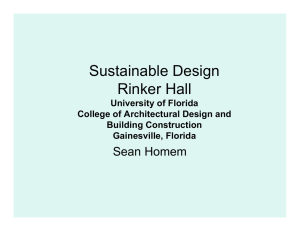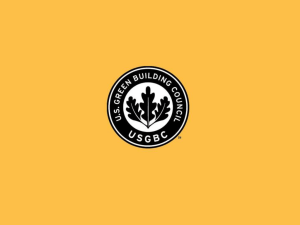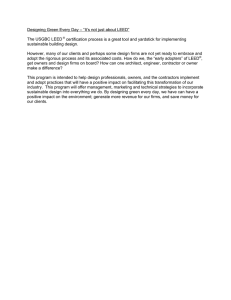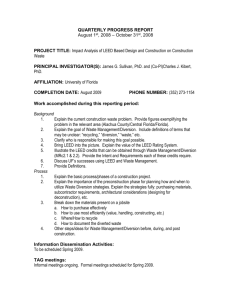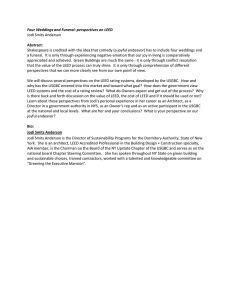Construction and Demolition Waste Management
advertisement
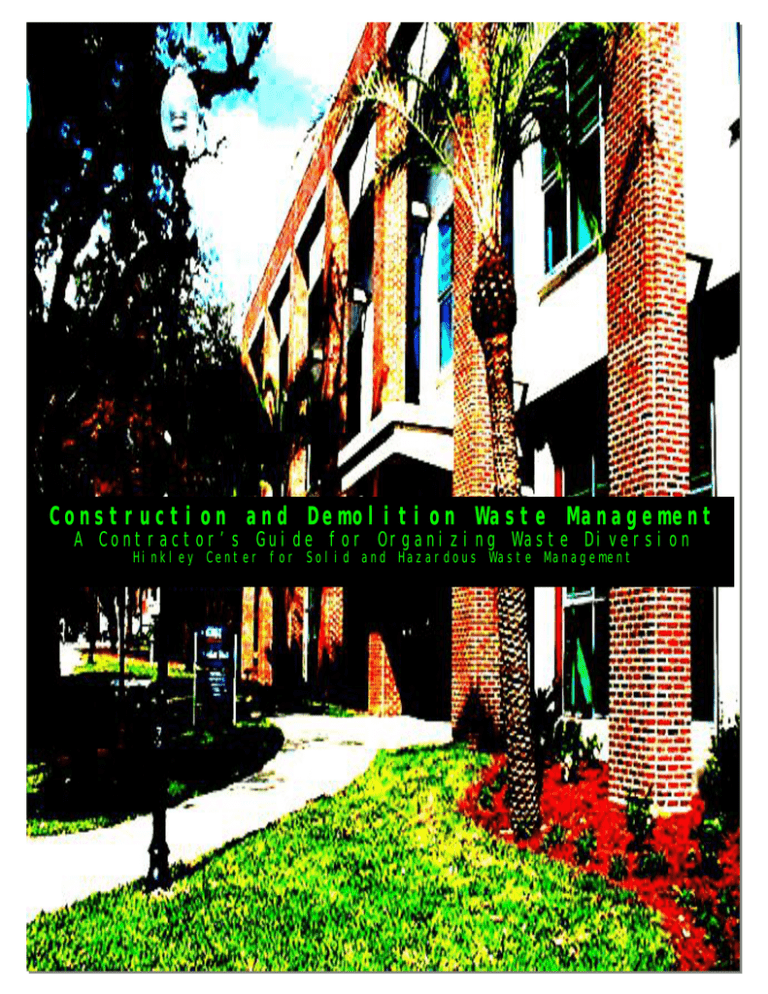
Construction and Demolition Waste Management A Contractor’s Guide for Organizing Waste Diversion Hinkley Center for Solid and Hazardous Waste Management - Hinkley Center for Solid and Hazardous Waste Management - - Hinkley Center for Solid and Hazardous Waste Management - Construction and Demolition Waste Management A Contractor’s Guide for Organizing Waste Diversion Hinkley Center for Solid and Hazardous Waste Management - Hinkley Center for Solid and Hazardous Waste Management - - Hinkley Center for Solid and Hazardous Waste Management - Introduction Welcome The following document aims to provide responsible contractors with a guide for managing the waste generated on their construction projects. The document will C&D is used as an abbreviation discuss the current statistics relevant to C&D waste. These statistics emphasize the for Construction and importance of limiting the amount of waste discarded to landfills. Following these Demolition. statistics is a series of techniques contractors can utilize for waste reduction. Methods are discussed for preconstruction, construction, and post-construction phases of a project. If used properly, this document should be an effective method for developing a waste management plan, limiting C&D waste, and improving the current environmental conditions. Throughout the document, supplementary information and relevant definitions are located in the green column next to the main text. This information may be helpful for individuals who are unfamiliar with the C&D industry and its terms. Table of Contents Background and Approach 1 USGBC and Connection 2 Waste Issues in Florida 3 University of Florida Success 4 University of Florida Case Study 5 Material Selection Criteria 6 Process Preconstruction 7 Construction 8 Post Construction 10 Conclusion 10 - Hinkley Center for Solid and Hazardous Waste Management - - Hinkley Center for Solid and Hazardous Waste Management - Background and Approach Background and Statistics Construction and Demolition Debris (C&D) is defined in Florida Statute 403.703 as “Discarded materials generally considered to be not water-soluble and nonhazardous in nature, including, but not limited to, steel, glass, brick, concrete, asphalt roofing material, pipe, gypsum wallboard, and lumber, from the construction or destruction of a structure as part of a construction or demolition project or from the renovation of a structure, and includes rocks, soils, tree remains, trees, and other vegetative matter that normally results from land clearing or land development operations for a construction project, including such debris from construction of structures at a site remote from the construction or demolition project site.” Currently, the U.S. EPA estimates more than 136 million tons of debris is generated U.S. EPA is an abbreviation for annually by building-related construction and demolition. This value indicates that over United States Environmental 40% of the C&D and municipal solid wastestream is a direct result of the construction Protection Agency. industry. Considering that the construction industry accounts for only 8% of the GDP, the amount of waste generated is not proportional. These statistics confirm the urgent need for modification of the techniques currently used in the C&D industry. Approach Waste Management Plans are Some modifications are presently being developed and tested in the C&D industries. The formation of Waste Management Plans has, thus far, proven to successfully reduce also referred to as Waste Diversion Plans. the total quantity of waste transferred to a landfill. In general, these plans aim to limit the amount of waste transported from C&D sites to landfills. The plans achieve this by incorporating a series of waste reduction techniques appropriate to the project. Some of the techniques commonly used in Waste Management Plans are appropriate material USGBC is an abbreviation for selection, construction site arrangement, recycling appropriate materials, and proper United States Green Building documentation. Council. Waste Management Plans are frequently used if a construction project sets a goal to limit the negative environmental impacts resulting from the construction. Usually these LEED is an abbreviation for Leadership in Energy and projects aim to achieve a sustainable certification. Currently, the most common certification Environmental Design. system used is the USGBC’s LEED rating system. 1 - Hinkley Center for Solid and Hazardous Waste Management - USGBC and Connection USGBC and LEED Green Building Rating Systems LEED Green Building Rating Systems: New Construction and Waste management practices are also seen in the USGBC’s LEED rating systems. Major Renovations, Existing The USGBC has been highly effective in changing the environmental ethics of Building Operation and construction. The USGBC aims to improve conventional construction methods by Maintenance Improvements, implementing a series of LEED Green Building Rating Systems. Currently the most Commercial Interiors, Building Core and Shell, Schools, Retail, popularly used rating system is LEED for New Construction and Major Renovations Healthcare, Homes, and (LEED-NC). The LEED-NC rating system classifies the 69 possible points into six Neighborhood Development. categories: Sustainable Sites, Water Efficiency, Energy and Atmosphere, Materials and Resources, Indoor Environmental Quality, and Innovation and Design Process. Each category contains a series of possible credits relating to the category that the project team can achieve during planning, construction, and building operation. Connection to Waste Management Each credit is detailed by intent, requirements, possible options, potential technologies and strategies, and the number of points available. The Materials and Resources category previously discussed is the most relevant category when discussing waste management. The second credit under the MR category is titled Construction Waste Management. This credit offers up to two points for properly managing construction waste on the project. One point is awarded to projects that successfully divert 50% of the total waste generated from construction or demolition. The One additional point can be achieved as an exemplary performance credit under the second point is awarded for diverting 75% of the total waste. The quantity of total waste Innovation and Design category does not include any hazardous materials. if 95% of the total waste is In order to achieve these credits simply, the contractor should form a plan to achieve a diverted. number of goals, ultimately aiming to reduce the waste transferred to a landfill. This plan is, in fact, a Waste Management Plan. Usually these plans include analyzing the project, site set-up, researching materials recyclability, getting the subcontractors and workers involved, and compiling pertinent documentation. Proper preparation of the Waste Management Plan will ensure the construction project generates minimal waste. Though used infrequently at this time, projects that do utilize waste management plans see positive results. The following section documents the success The University of Florida has experienced through use of waste management plans for eleven LEED certified buildings on the campus. 2 - Hinkley Center for Solid and Hazardous Waste Management - Waste Issues in Florida Florida Before the USGBC and LEED movement, there was little influencing or governing a For additional legislative and contractor’s requirement to recycle. Until 1997, Florida had minimal requirements for regulatory background read C&D recycling. In 1988, legislation established C&D recycling goals for each county, but C&D Debris Recycling Study: it wasn’t until 1997 that this C&D disposal legislation was reinforced. The stricter Final Report. disposal requirements resulted in increased desire to recycle C&D debris. Alachua County In Alachua County, the enforcement of legislature may have been the cause for the lower percentage of C&D waste in 1998. The Florida Department of Environmental Protection recognized C&D waste in Alachua County as 17% in 1998, while the percentage of C&D waste in 1996, 1997, 1999, and 2000 were between 23% and 29%. For additional information on Waste in Florida Counties visit http://www.dep.state.fl.us/waste/ These figures remained steady both before and after the drop in 1998. It wasn’t until 2004 that a decrease in C&D waste was observed again. In 2004, The Florida Department of Environmental Protection credited C&D Waste for 14% of the total waste generated in Alachua County. It was also in 2004 that the first LEED certified building was built on the University of Florida campus. This figure is down drastically from 29% in 2000, and is also a great accomplishment compared to the national C&D percentage; estimated to be 40%. Map of Florida and Alachua County obtained from Wikimedia Commons and can be downloaded here. The city of Gainesville is highlighted in red. 3 - Hinkley Center for Solid and Hazardous Waste Management - University of Florida Success The University of Florida This decrease of C&D waste recorded in 2004 in Alachua County may be a result of the University of Florida’s efforts to build highly efficient buildings. With use of the USGBC’s LEED Green Building Rating Systems, the University of Florida has constructed eleven certified buildings to date. The University currently has thirty-one projects registered with the USGBC. All future construction aims to achieve certification. In fact, all new construction at the University of Florida is required by the college to Visit University of Florida’s Facilities Planning and achieve a LEED Gold Certification. Since the university currently requires high standards Construction at: for building efficiency, reaching certification does not require much additional cost or http://www.facilities.ufl.edu/. effort. The university has a number of methods in place to ensure the success of all construction projects. One of the methods utilized is the University of Florida Solid Waste Reduction Program. This program offers recycling of paper products, cardboard, plastics, batteries, scrap metal, yard debris, glass, lumber, and a variety of other materials. This program, in conjunction with various contractors’ Waste Management Plans, has allowed approximately 82% of the waste produced on a project attaining MRc2.1 or 2.2 credits to be diverted from landfills, as shown in the figure below. The success of the University of Florida’s Recycling and Waste Management Plans may be responsible for the drastic The figure provided here is an decrease recorded in C&D waste in Alachua County over the past four years. analysis of the University of Florida LEED certified projects attaining MRc2.1 and/or 2.2. The projects highlighted in blue have achieved certification while projects in white are awaiting certification. The column highlighted in green provides total material quantities (in tons) for all University projects aiming to achieve points under MRc2. 4 - Hinkley Center for Solid and Hazardous Waste Management - University of Florida Case Study M.E. Rinker Hall M.E. Rinker Hall was completed in 2003 and awarded LEED Gold certification in 2004. The building was constructed by Centex Rooney Construction Company. Housed on the University of Florida campus, the buildings intended use is for the students and faculty of the M.E. Rinker, Sr. School of Building Construction. General Information Built in 2003. Gross Square Footage Totals 46,530. Facilities include Classrooms, Laboratories, Faculty Offices, & Campus Support Services. Building accommodates four research centers: Shimberg Center for Affordable Housing, Powell Center for Construction and Environment, Fluor Program for Construction Safety, Center for Collective Protection LEED Facts UF’s First LEED certified building. Used LEED-NC Rating System. Achieved 40 out of 69 possible points. Achieved a Gold Rating. Project utilizes rainwater harvesting, reclaimed water for irrigation, waterless urinals, utilized regional materials, and 50% energy savings over the ASHRAE 90.1 standard. Waste Diversion Achievements Achieved both MRc2.1 and 2.2 Diverted 84% of total waste generated on project. Successfully recycled asphalt, concrete, cardboard, gypsum board, and steel. The waste diversion achievements on the Rinker School were a direct result of the M. E. Rinker Hall C&D Waste and Diversion well-developed Waste Management Plan created by Centex Rooney Construction and representatives from the University of Florida. The Waste Management Plan began by analyzing the project by each phase of construction. For the preconstruction phase, the Asphalt 18% Waste 16% Cardboard and Paper 0% Sub-base 21% team developed a plan to select appropriate materials, purchase the correct quantity, set up the site successfully, and set waste diversion goals. During planning for the construction phase, the team would monitor the plan, supervise workers’ ability to handle Metals and Plastics 0% Land and Site Debris 6% Concrete, CMU, Brick 38% Gypsum 1% and dispose of materials properly, and document the waste created and diverted. Post construction the team would complete the appropriate documents for the USGBC and determine the victories and failures of the project to ensure success on the next project. During the actual construction, the team followed the Waste Management Plan and achieved their goal, satisfying both MRc2.1 and 2.2 by diverting 84% of the waste generated. The success was a direct result of the team’s ability to follow the Waste Management Plan. - Hinkley Center for Solid and Hazardous Waste Management - 5 Material Selection Criteria Process for Selecting Appropriate Construction Materials The following explains the appropriate process for selecting and purchasing construction materials. Each suggestion is detailed with a clear objective and strategies helpful to achieve the objective. Resource Quantity Objective: Since the overall aim of waste management is to limit the amount of waste produced, material purchasing would be the root of the goal. By purchasing less of a material, the resource will be used in smaller amounts and more efficiently. Ultimately, there will be less waste. Strategy: In order to achieve this task, a capable material estimation technique should be utilized. This method should be evaluated at the conclusion of each project to ensure the method is up-to-date and capable of outputting acceptable quantities. Purchasing materials in a series, as opposed to in bulk, may also cut down on resource quantity. During the last purchase only what is needed will be ordered. This will also limit the amount of materials onsite, and the materials exposure to weather and other damaging factors. The strategies documented here were developed by Public Technology Inc. in association with the USGBC. These strategies were part of a resource efficiency document presented in the Sustainable Building Technical Manual. Reused Materials Objective: There are a number of products and materials that can be easily reused. Some of these products include doors, glass, and metals. Though deconstructing to be sure products are reusable might cause additional effort, the cost savings of using a salvaged material can be considerable. The goal is to keep these useful materials and products away from a landfill. Strategy: Contact a salvage company. The salvage company can assist by coming on-site and removing valuables or by providing the project with valuable products for reuse. Either way, the materials will avoid becoming waste. Utilizing enough of these materials can provide up to two LEED credits: Materials and Resources credit 3.1 and 3.2. Recycled Content Objective: Utilizing materials with recycled content limits negative effects on the natural environment in two ways: fewer resources must be extracted from the environment and the recycled material used for replacing the resources is diverted from a landfill (waste diversion). Strategy: Purchase materials with a high percentage of recycled content. Recycle all waste capable of being used in creating a recyclable product. Utilizing enough of these materials can provide up to two LEED credits: Materials and Resources credit 4.1 and 4.2. Life Cycle Cost Objective: Selecting a product or material based on the Life Cycle Cost is advantageous for the future of the building. Some materials will not outlast the life of the building, for this reason they will have to be replaced and may end up in a landfill. Strategy: Select products based on the Life Cycle Cost to ensure the products will not need to be replaced in the near future. By expanding the life of the product, it will not need to be replaced as often. Replacing a product less will ultimately result in less products failing and ending up in a landfill. Therefore selecting materials with a longer life span will ultimately divert waste. Rapidly Renewable Resources Objective: The USGBC defines these resources as a material or product “made from plants that are typically harvested within a ten year cycle or shorter.” The goal of utilizing these resources is to limit the use of nonrenewable resources. Strategy: Purchase and use rapidly renewable resources to replace other resources not capable of quick renewability. These materials may include bamboo, cotton insulation, or cork. If enough rapidly renewable resources are used, it can provide an additional LEED credit: Materials and Resources credit 6. - Hinkley Center for Solid and Hazardous Waste Management - 6 Process Preconstruction Tasks Preconstruction is the phase of the construction process that The following process outlines the activities and tasks that should be followed during comes before the actual preconstruction. These activities and tasks will ensure proper preparation for a successful construction of the structure. Waste Management Plan. There are four main activities divided into multiple tasks. The This process usually includes first activity requires the development of the project’s goals for waste management. It is initiating and aligning the project team, discovering the project imperative that these goals are realistic to the project and reiterated to all parties requirements, finding project throughout the project’s duration. boundaries, and developing a 1. Develop main goals of the Waste Management Plan. GOAL 1: This project will generate the least amount of waste possible. GOAL 2: The majority of the waste created on this project will be recycled. GOAL 3: Work to guarantee full involvement in the plan. GOAL 4: Be knowledgeable of Waste Management Plan’s progress and efficiency. budget and schedule. 2. Explore required materials. Run through project plans and specifications and determine what materials will be utilized on the project and may produce waste. Determine the amount of materials that will be sufficient yet produce the least waste. When purchasing materials consider the material selection criteria previously discussed: resource quantity, reused materials, recycled content, etc. Examine specifications for areas in which recycled materials can be used as an alternate to the materials selected by the architect or owner. Refer to Construction Material Purchasing and Planning Guide to ensure materials selected are as beneficial to environment as possible. Utilize the Waste Diversion Assessment Plan to estimate anticipated waste for materials on the project. Also using this document, determine which facilities in the area will divert the estimated waste and what diversion method will be used to ensure maximum recyclability. Set the Project Diversion Goal at the bottom of the Diversion Assessment Plan. “This project will divert XX% (by weight) of the total waste generated.” Purchasing and Planning 3. Select a Waste Management Coordinator Qualify and select a Waste Management Coordinator to ensure worker involvement and proper organization of the diversion process. Individual should posses a LEED AP certification and be knowledgeable in waste diversion practices. The Coordinator should contact the chosen recycling and waste facilities to inquire which materials are acceptable, acquire the necessary dumpsters and/or recycling receptacles, and organize collections and/or drop offs for the duration of the project. Be sure these facilities can provide proof of trash/recyclables weight and receipts tracking the transfers. The Coordinator should be aware and confident in the Project Diversion Goal. The Coordinator should ensure each subcontractor is familiar with the LEED process, especially Material and Resource credits 2.1 and 2.2. The Coordinator should present the Waste Management Plan, goals, and Project Diversion Goal to each subcontractor and key players on the project. These individuals must agree to the plan and sign-off on the goal sheet. Be sure the goals and policies also exist in the Subcontractor’s contract with the General Contractor. The Coordinator should assist management in organizing the project site. The Construction Material Guide details a variety of construction materials. The document specifies effective methods for purchasing, efficient instructions for use and handling, and also provides a series of reuse and/or disposal strategies for each construction material included. When utilizing the Waste Diversion Assessment Plan consulting the Construction Material Purchasing and Planning Guide is a helpful way to determine a suitable diversion method for each material. 7 - Hinkley Center for Solid and Hazardous Waste Management - Process Preconstruction Tasks (Continued) 4. Set up project for the success of the Waste Management Plan. a. Site: Determine how many bins and of what size will be required for this specific project. Depending on the type of building and project requirements, bins could be provided for all or some of the following: asphalt, cardboard, concrete/CMU/brick, glass, gypsum board, paper, plastic, metal, and wood. When selecting bins consider larger receptacles with multiple compartments. Also consider smaller bins to place in more locations for materials that will be recycled more frequently. Smaller bins with wheels are advantageous for end of the day collection into the larger bin. Set up a site plan that will designate the main location for waste and recycling containers, as well as locations for smaller bins. Smaller bins should be located by workspaces needing these bins. Be sure the dumpsters and recycling receptacles are easily accessible for pick-up. Be sure each dumpster or receptacle is marked to clearly identify which materials are acceptable: “Metal Only,” “Concrete/Rubble,” “Clean Wood,” etc. Mark areas for material storage to protect from weathering or other damage. Set up a mutual cutting area. This ensures reuse of materials before cutting of new ones. b. Office: Designate an area for the office or jobsite trailer to establish receptacles. Provide separate bins for recyclable materials: aluminum, plastic, paper, ink cartridges, etc. Assign a specific area for filing the Waste Management Plan, Goals, and all corresponding documents. Construction Tasks Setting up smaller waste collection bins at worksites will allow workers to recycle their materials quickly without having to travel from their workstation and waste valuable time. Designating smaller bins to a specific trade will result in one waste material filling most of the bin. This will allow for easy site separation. Construction is the phase of the project during which physical The following process outlines the activities and tasks that should be followed during materials begin to form the actual project duration. Perhaps the most important activity during the entire procedure is structure. This phase includes listed second: Managing the Waste Diversion Process. The tasks scheduled during this preparing the project site, activity must be performed successfully to ensure the success of the plan. Managing the providing a foundation, building vertically, constructing a roof, process should be performed by a competent and capable individual known as the Waste and finishing the interior and Management Coordinator; who was selected during the pre-construction tasks. exterior of the structure. 1. Materials Follow tips provided on Construction Material Purchasing and Planning Guide to ensure efficient use, proper handling, disposal methods and reuse strategies of specific materials. Carefully handle and store materials to ensure no materials are broken and materials can be reused where possible. Return any excess materials that are not used to the vendor. If they cannot be returned offer to the owner, workers, or donate the materials to a charity before considering it waste. Coordinate material deliveries with schedule to minimize the amount of time materials are onsite and exposed to weathering or damage. Maintain construction equipment properly to guarantee maximum life. 8 - Hinkley Center for Solid and Hazardous Waste Management - Process Construction Tasks (Continued) 2. Managing the Waste Diversion Process Management should monitor Waste Management Coordinator to make certain the following responsibilities are completed appropriately. The Coordinator must remind subcontractors of the goals and responsibilities for the Waste Management Plan. This should be done throughout the entire project duration. The Coordinator should also post the Waste Management Goals in a prominent location for all to view. The Coordinator should provide tours to all workers, ensuring their knowledge of proper waste sorting and placement. The Coordinator should provide each subcontractor with a site plan clearly marking which areas are designated for storage, cutting, and recycling. Trash and recycle bins should be clearly marked with acceptable materials. The Coordinator should be present at safety or toolbox meetings to remind workers of their commitment to waste diversion. This is also an effort to keep workers motivated. Coordinator must monitor each subcontractor and worker’s actions to ensure the proper placement of recyclable materials. Subcontractors should aim to reuse their own materials on the project. If not possible, subcontractors can save their materials for a future project. Subcontractors should aim to keep their waste separate from other’s waste to ensure easy separation for recycling. If it is found that workers are not taking initiative to separate the materials, require them to pick through the trash they produced and hand separate the materials. This will limit contamination by workers in the future. Suppliers should be urged to use sturdy pallets and pick them up for reuse. Coordinator should periodically check receptacles and trash to make sure materials are not in the wrong bin. When a dumpster or recycling receptacle is full it is the Waste Diversion Coordinator’s duty to arrange a pick-up. The Coordinator must oversee proper procedure for all documentation of waste and diverted materials. Remember: It is crucial for the Waste Coordinator to remind subcontractors of their responsibilities and to ensure proper execution of the waste management program. The Jobsite C&D Debris Log will assist the project team and Waste Management Coordinator 3. Documentation Upon dumpster or recycling bin removal, fill out a Jobsite C&D Debris Log. Be sure this document is filled out fully with material descriptions, quantity of materials diverted and taken to the landfill, totals of these materials, location materials were taken to, and finally signed by the appropriate parties and filed correctly. Get verification from waste facilities of diverted and non-diverted waste. Any verification from the collection facility, such as receipts or pull tickets, should be attached to the Jobsite C&D Debris Log. File these documents correctly. Utilize Jobsite C&D Debris Logs to create a monthly progress report to present to the owner, subcontractors, and workers. Keep track of diversion costs and savings. Submit to appropriate department. Document plan with photographs throughout project duration. If possible keep a Photo Log. to document all waste correspondence. If accurate records are kept, each Job C&D Debris Logs will provide the total waste generated, waste diverted, and percentage of waste diverted for each pull. With the percentage of waste diverted from each pull and the Project Please visit the appropriate appendices to better understand the requirements and Diversion Goal located on the documentation involved with the Waste Management process. The documents provided in log, the Coordinator can easily Appendices B through D can be used to estimate, log, and monitor the project’s waste compare and track the waste diversion progress of the project. process. The documents can also be submitted to the USGBC as correspondence in hopes of attaining MRc2 approval. - Hinkley Center for Solid and Hazardous Waste Management - 9 Process and Conclusion Post Construction Tasks Post construction is the phase during completion of the Post construction tasks consist of two vital activities: further documentation and construction project. This phase awards. These activities are to be performed in the last phase of project completion. The involves completion of punch-list first of these tasks continues to explain the importance of proper documentation of the items, owner approval, and waste diversion and management process. Proper documentation will assist future project project closeout. teams in a few ways. Keeping accurate waste records will illustrate which materials The Jobsite C&D Debris produced excess waste. For future projects, the estimating, handling, and diversion Project Totals is composed of techniques associated with materials producing excess waste should be assessed. two sheets. The first sheet can 1. Documentation Examine and total all Jobsite C&D Debris Logs. Fill out final Jobsite C&D Debris Project Totals Determine the percentage of Overall Waste Diverted in pounds. Compile all necessary documentation for LEED MRc2.1 and 2.2 to turn into USGBC. Compare percentage of Overall Waste Diverted to the Project Diversion Goal. Determine how efficient the project has managed the waste and what can be done to improve the efficiency. Determine which materials had the largest amount of excess material and if the current material estimating strategy should be reassessed. For future use, document which facilities were most accommodating at diverting waste. be used as many times as necessary and allows the project team member to enter the data from all Jobsite C&D Debris logs. In fact, this sheet can be filled out during project duration. The second sheet totals all waste data placed on the first sheet, and thus, all waste data from the 2. Awards duration of the project. If used In order to ensure future participation, provide Subcontractor’s who excelled in waste diversion with a symbol of appreciation. correctly, this sheet will provide the USGBC with the percentage of waste diverted and associated Conclusion applicable points if approved. In summation there are a number of tasks and activities that must be performed in order to have a successful waste management plan. Though all the mentioned tasks are important, keeping proper documentation throughout the duration of the construction project may be the most necessary task. Proper documentation will result in tracking project progress, understanding successes and failures, correcting errors in the future, developing a more efficient waste management plan, and achieving LEED certification. If followed correctly, the activities and tasks included in the preconstruction, construction, and post construction phases can successfully assist construction project teams in assuring the maximum amount of waste is diverted from landfills and incinerators. 10 - Hinkley Center for Solid and Hazardous Waste Management - - Hinkley Center for Solid and Hazardous Waste Management -
